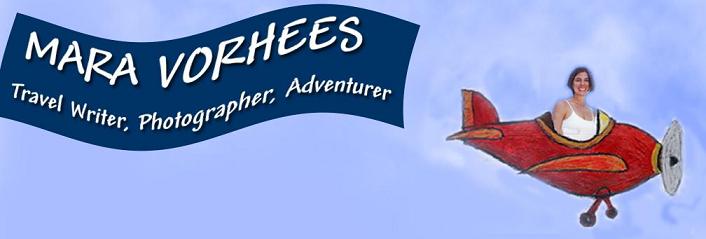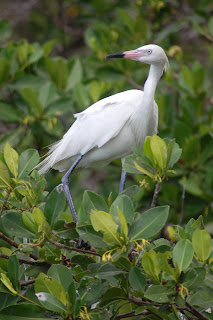Caye Caulker -- "I think I'll look at the pelicans," Jerry announced this morning, as we discussed how we should spend our last day in Belize. By this time tomorrow, we will both be on airplanes: Jerry heading home to Boston, and me on my way to an author workshop in San Francisco.
After a month of climbing on Mayan ruins and exploring the caves and jungles of Cayo, "looking at the pelicans" is not exactly a climactic conclusion. But as I already mentioned, Caye Caulker is the kind of place where sitting on the dock and watching the birds is a perfectly legitimate activity.
We have already wiled away about two weeks doing I-don't-know-what. We have taken our cues from Calvin and Hobbes, who in the book The Days are Packed, spent their summer vacation daydreaming, philosophizing and watching the sunset.
Jerry and I spent a lot of time frolicking with the fish. Belize boasts the largest coral reef in the Western Hemisphere (second in the world after the Great Barrier Reef in Australia). So needless to say, the diving and snorkeling is phenomenal. Snorkel guides offer boat trips to various marine sanctuaries and different spots on the reef. Some sites are stunning for their amazing array of colorful coral formations; others attract nurse sharks, or sting rays, or angel fish.
I took four different trips, which means I snorkeled in eleven different sites along the reef (plus once or twice off the dock near our guesthouse). Every spot has its highlights, but my favorite was the Blue Hole, an ancient underwater cave that collapsed in on itself. As a dive site, it is famous for the stalactites and stalagmites that make it a geological wonder. It is 300 feet deep at its center, but it is surrounded by coral, which makes for fantastic snorkeling around the edge. This is a two-hour boat ride from Caye Caulker, so relatively few boats make it out here. The coral is pristine and vibrant, even compared with the reef closer to shore. The deeper water is home to huge grouper and other biggies that you don't normally see in the shallow parts of the reef. Meanwhile, parrotfish, angelfish and squirrelfish float freely, paying us no apparent heed. Huge schools of electric blue tangs invite us to follow their lead, grazing on one coral formation then another.
One of the appeals of this underwater world is its atmosphere of serenity. Ironic, when you consider that these fish spend most of their time and energy trying not to get eaten.
In addition to the ictheus, we also got to know a new sea mammal. We spent a morning at Swallow Caye, home to a population of West Indian manatees. These creatures embody the concept of "gentle giant". Weighing as much as 1600 pounds, they are vegetarians and they have no natural predators (at least in Belize, where hunting them is illegal).
You might wonder how much vegetation a huge creature like that has to eat to sustain himself. The answer is over 100 pounds a day! As such, he has to spend up to eight hours a day grazing on sea grass (thus earning him the nickname "sea cow").
"Basically, the philosophy of the manatee is Live and Let Live," explained our guide Harry, with obvious approval.
Besides living the Life Aquatic, we have explored this island from end to end, both by bike and by kayak. We have eaten at just about every restaurant (for better or for worse), sampled all kinds of ceviche and drunk our fair share of Belekin beers. We watched the sunrise from the beach and the sunset from the back dock.
And now we are out of time. I better get out there and look at the pelicans.
Signing off from Belize. Check back in a week or so, when I will log on from Venice, Italy.








 A few days later, I got up the guts to reveal my identity. I went looking for I&I and I found him overseeing a paint job on his sailboat. I told him that I was responsible for the story and the photo (but not the caption). "I wasn't mad!" he insisted.
A few days later, I got up the guts to reveal my identity. I went looking for I&I and I found him overseeing a paint job on his sailboat. I told him that I was responsible for the story and the photo (but not the caption). "I wasn't mad!" he insisted. 

 Chacalacas. This pair of these funny birds was living in a tree, just outside the window at our lodge in Cayo. They are named for their song (if you can call it that), which they like to sing as the evening sky grows dark. "Cha-ca-la-ca-la-ca!" Charming though it is, this is not a particularly well-known bird. So you can imagine my surprise when my friend A. recently wrote to me "Give my regards to the chacalacas!" (Somehow, we bird people find each other.)
Chacalacas. This pair of these funny birds was living in a tree, just outside the window at our lodge in Cayo. They are named for their song (if you can call it that), which they like to sing as the evening sky grows dark. "Cha-ca-la-ca-la-ca!" Charming though it is, this is not a particularly well-known bird. So you can imagine my surprise when my friend A. recently wrote to me "Give my regards to the chacalacas!" (Somehow, we bird people find each other.)
 Roseate Spoonbills. Sittin' in a Tree. N-E-S-T-I-N-G. You know how this story ends. We could see the chicks too, but it was hard to get a good, clear photo as they were hiding amidst the branches. The fuzzy, blackish birds in the background are the young reddish egrets, who were nesting in the same place. Disclaimer: I did not find the roseate spoonbill nesting place on my own! It's a tiny island somewhere west of Ambergris Caye, which we did a quick drive-by on a snorkeling trip.
Roseate Spoonbills. Sittin' in a Tree. N-E-S-T-I-N-G. You know how this story ends. We could see the chicks too, but it was hard to get a good, clear photo as they were hiding amidst the branches. The fuzzy, blackish birds in the background are the young reddish egrets, who were nesting in the same place. Disclaimer: I did not find the roseate spoonbill nesting place on my own! It's a tiny island somewhere west of Ambergris Caye, which we did a quick drive-by on a snorkeling trip.
 Osprey in her nest atop a telephone pole. She clearly did not like us riding our bikes in circles around her pole, as she was making quite a racket. We actually saw two more osprey when we were out kayaking yesterday and they were such posers! Unfortunately, no camera in the kayak, which is probably why they were posing.
Osprey in her nest atop a telephone pole. She clearly did not like us riding our bikes in circles around her pole, as she was making quite a racket. We actually saw two more osprey when we were out kayaking yesterday and they were such posers! Unfortunately, no camera in the kayak, which is probably why they were posing.
 Black-neck stilt. These guys were also hanging out in the wetlands along the side of the airstrip. We didn't know what they were, but they were easy to identify thanks to their extremely long, extremely skinny, extremely pink legs. When these birds take off, those pinkies stream behind them like an airplane banner. I'm not sure what the one in front is doing - looks like an arabesque.
Black-neck stilt. These guys were also hanging out in the wetlands along the side of the airstrip. We didn't know what they were, but they were easy to identify thanks to their extremely long, extremely skinny, extremely pink legs. When these birds take off, those pinkies stream behind them like an airplane banner. I'm not sure what the one in front is doing - looks like an arabesque. Oh wait, that's not a bird
Oh wait, that's not a bird Red-footed boobie bird. Apparently these birds are rare, but you would never know it when you go to Half Moon Caye, a small island southeast of Caye Caulker. Again, I can't take credit for finding the nesting grounds of the red-footed boobie, as we stopped here on a snorkel trip. The place was just swarming with them.
Red-footed boobie bird. Apparently these birds are rare, but you would never know it when you go to Half Moon Caye, a small island southeast of Caye Caulker. Again, I can't take credit for finding the nesting grounds of the red-footed boobie, as we stopped here on a snorkel trip. The place was just swarming with them. Magnificent frigate bird. These guys are flying all over this island, but they don't often sit still long enough for a photograph. We have been entertaining ourselves by observing them fish. One bird catches something and three others try to steal it right out of his mouth. No catch is safe until it's in the stomach.
Magnificent frigate bird. These guys are flying all over this island, but they don't often sit still long enough for a photograph. We have been entertaining ourselves by observing them fish. One bird catches something and three others try to steal it right out of his mouth. No catch is safe until it's in the stomach. Brown pelican. Again, there is no shortage of pelicans in these parts, but how nice of this one to join us to watch the sunset!
Brown pelican. Again, there is no shortage of pelicans in these parts, but how nice of this one to join us to watch the sunset!





 The very rare harpy eagle turned out to be quite a show-off.
The very rare harpy eagle turned out to be quite a show-off. 




























